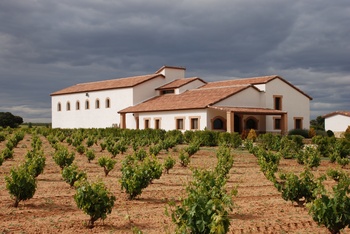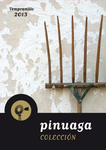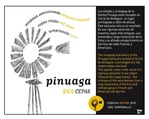
 |
| Valentin Pinuaga Salazar founded this small estate back in the 1960’s. Today the winery is run by Valentin and Esther Pinuaga - second and third generation of this family of traditional winemakers. The 90 hectares of vineyards and the winery are located in Corral de Almaguer, Toledo, a privileged site 800 meters above sea level, and surrounded by Mediterranean oak forests. The continental climate, with pronounced changes in day-and-evening temperatures, boosts the unique personality of the land and enhances the quality of the vines. It favors the growth of autochthonous grape varieties, allowing the production of varietally-expressive wines. Amongst these grape varieties, Tempranillo and Merlot vines are grown, which are different in age, soil, altitude and orientation. Each vineyard is always vinified separately. The Tempranillo vines are bush trained as this is the best growing technique for the area. A bush vine is made up of irregular branches, growing directly from the soil and reaching up to 3.2 feet high. That enables the bunches to be well ventilated and spread out from each other. The soil is mainly clay-limestone. The grapes are all hand harvested (starting at 4am because of the heat), at very low yields of 2,500 kg/ha, and in small cases of 10kg. Choosing the right picking time is crucial. The vineyards are sampled up to three times per week. Detailed observations, such as the health of the vineyards, the physical condition of the seeds and skins, the ripeness of the berries and pips, together with lab analyses, enable to pick at optimum ripeness. Total production is around 100,000 bottles. Farming/winemaking practices: Certified organic since 2010. Wild grass usually grows freely from the month of October until April and the vineyard borders are maintained with indigenous flora to enable beneficial insects to complete their life cycle. Fertilizing is kept down to a minimum, and only comes in the form of manure. Fungal sprays are essentially in the form of sulphur, and the treatment is done vine per vine. |
| Pinuaga Website |
 |
| Nature |
| 100% Tempranillo. The grapes come from 10ha of 22 to 45 year old bush-planted vines, from two parcels located on the bank of the Riansares river, at 750 meters above sea level. The soil is red clay and pebble stones. The grapes are hand-harvested in September, at night, and put in small cases. They are sorted at the winery, destemmed, and put in small stainless steel tanks for a 10 to 13 day fermentation, using indigenous yeasts. The wine is then aged for 4 months in French and American 300 liter oak barrels (2 and 3 year old). 2500 cases produced. Lively red berries aromas ( strawberries and raspberries) with a good freshness on the palate, and a silky texture. This wine is ideally suited to Mediterranean cuisine. |
 |
| Colleción |
| 100% Tempranillo. The grapes come from a single vineyard of 6 ha named la Lastra - in Latin, "flat stone", that the Romans used to pave the roads. The soil composition is alluvial, a combination of clay, silt, sand and gravel that forms over time, from mineral deposits left by running water. These soils act as thermo-regulator, retaining the heat, the water, and providing a more mineral character to the wine. The gobelet-trained vines average 22 year old. The grapes are hand-harvested at night early September, in small boxes. They are sorted, destemmed, and crushed to obtain maximum extraction. Cold pre-maceration during 2 days, and fermentation with indigenous yeasts in stainless steel tanks for 25 days. Delestage during the initial phase of the fermentation. The wine is then aged for 9 months in French and American 225 liter oak barrels (5% new oak, one and 2 year old barrels for the remaining). Predominant red fruit aromas, with notes of violet, and a hint of pepper and spices. 14% alcohol. |
 |
| 200 Cepas |
| 100% Tempranillo. Meaning "200 Vines", this is Pinuaga's flagship wine. The grapes come from a single vineyard of 3 Ha named El Aguila, planted with an old clone of Tempranillo locally called Cencibel. This special clone produces small berries that require a much longer ripening period than other Tempranillos. The ungrafted (pie franco) vines are at least 35 year old. The wine undergoes a 2 day cold pre-maceration in stainless steel tanks before the fermentation begins, with indigenous yeasts. It is then aged for 14 to 16 months in 225 liter French and American oak barrels, replaced every 3 years. The wine remains for another 16 months in the bottle before release. 416 cases produced. Deep ruby color, bright and attractive. Red fruit aromas dominate, well assembled with notes of violet and white pepper. The palate is full-bodied and very expressive, with a long finish. |
| Copyright © 2002-2017 VOS Selections, Inc. |